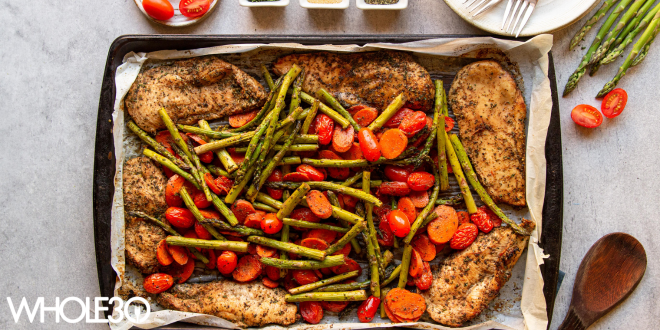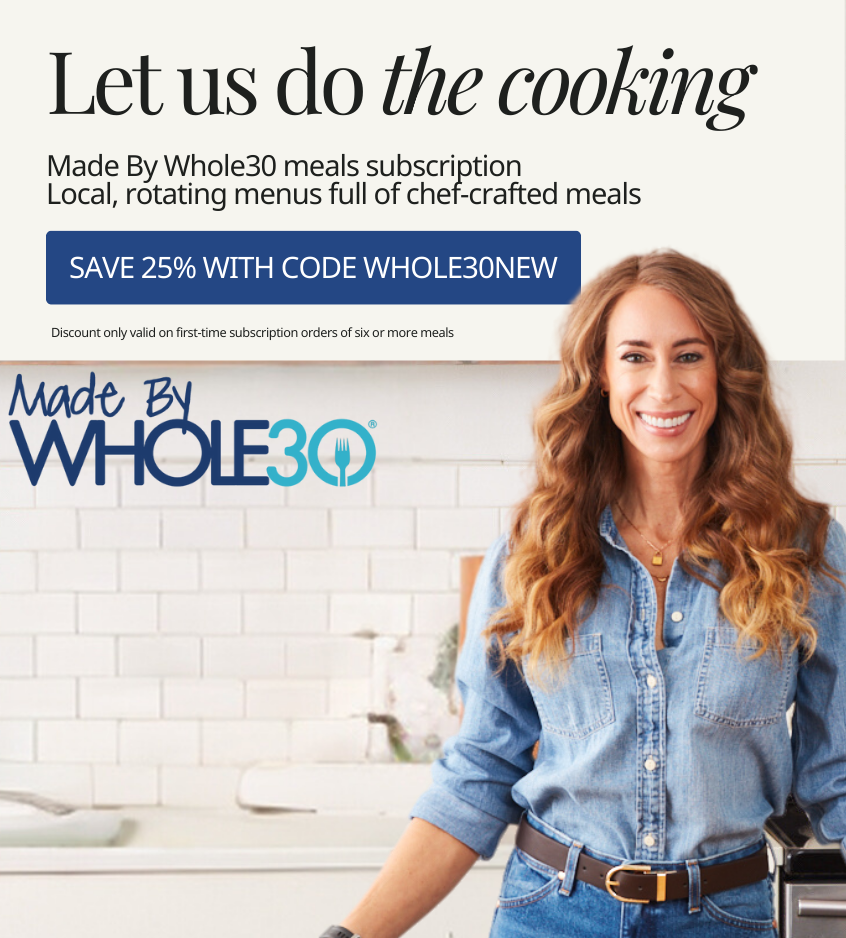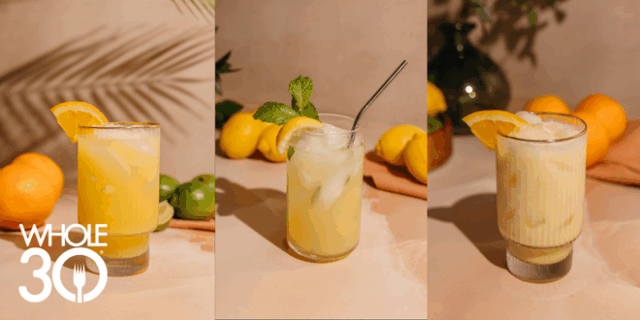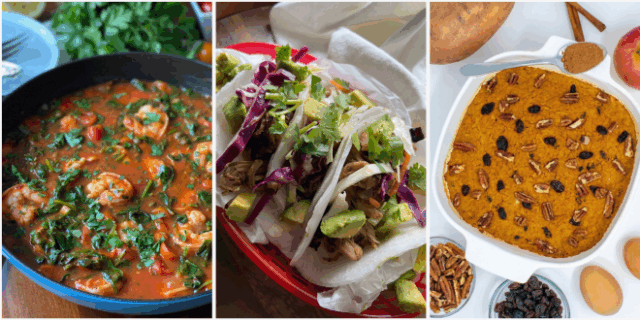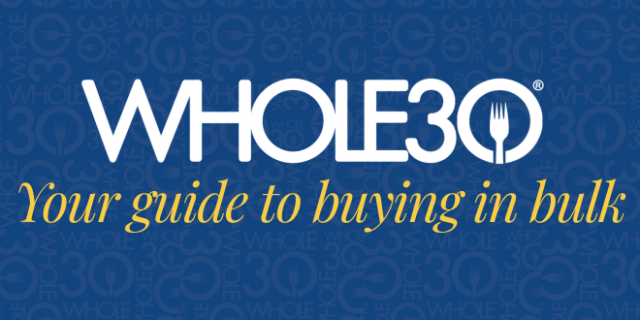Sheet pan dinners are one-pan dinners cooked in the oven. They can save time, simplify clean up, and generally don’t use specialized tools or kitchen appliances. They are fantastic for a mostly hands-off cooking process. Let the oven do most of your dinner work! Plus, they minimize the dishes down to just one. Today, we’re sharing 10 simple sheet pan tips to help make your Whole30 cooking easier.
The idea of cooking meat and vegetables all on one baking pan sounds easy. Just throw some chopped veggies and meat on a sheet pan, toss with oil and seasoning…voila? Well, done right, yes, sheet pan cooking can make your dinner prep so much easier. However, done wrong, it can end up with burnt or uncooked food, or even both on the same pan.
Let’s go through some basic sheet pan tips that will help empower you to add sheet pan cooking to your arsenal of kitchen skills.
Choose the right pan
Again, there aren’t many tools when it comes to sheet pan cooking. The two main ones you will need are an oven and a baking pan.
For the baking pan, make sure you choose a large pan that is rimmed. This means the sheet pan is not flat but has a ridge going all the way around it, like these. That rimmed edge will prevent juices or oil from spilling onto your oven floor. No one wants to interrupt dinner prep to deal with a mess on the bottom of a hot oven!
Ideally, the rimmed sheet pan is large – look for one that is a “half sheet pan” that is around 13”x18”. A smaller size means the food won’t have space to cook properly or all at the same time.
Line your pan for easy clean-up
One of the best parts of sheet pan meals is the easy clean-up! We know that dishwashing fatigue is a real thing in a Whole30. Make clean-up a breeze by lining your sheet pan. This will help you avoid having to deep scrub your pan after dinner. Line your baking pan with either heavy-duty foil or two layers of regular foil. You might still have to rinse off your baking pan if it was lined, but it’s easy-breezy compared to washing an unlined pan.
We recommend foil over parchment paper for sheet pan cooking. As it conducts heat, foil can help accelerate the cooking process and help browning. Parchment is better for delicate foods you don’t want to brown, like cookies.
*Safety note – Particularly if you are doing any broiling at the end of your sheet pan baking, consider using foil instead of parchment paper or at least make sure your rack is not too close to the broiler flame. Parchment is flammable and can create a flame if too close to a broiler flame.
Preheat your baking sheet
This step is optional but can help speed up the browning process if you really want those crispy potatoes or browned crust. It’s a simple step – when you turn on your oven to preheat, put your baking sheet in there too. Don’t remove it until you are ready to put your food on it. Letting your sheet pan get hot with the oven, or “preheating” your baking sheet, can help vegetables start to brown faster.
Oil and season your ingredients
Oil is important to help make sure your foods don’t dry out while roasting. So, make sure to completely coat your meat and veggies with oil before cooking. You can do this in a large bowl, tossing until everything is well coated. Or, you can do it directly on the sheet pan for fewer dishes. Just make sure you don’t add too much oil to the sheet pan that will prevent the ingredients from getting crispy, swimming in oil.
After tossing with oil, toss with your favorite seasonings. Whole30 Approved Primal Palate, Season the Moment, Oomph Cooking Blends, Pure Indian Food Spices, Healthy in a Hurry, Healthy Rican, and Noble Made Seasonings all specialize in Whole30 compatible seasonings that can vary and ramp up the flavor of your meal.
Not all foods cook at the same rate
Timing is especially important in a sheet pan. Important sheet pan basic fact: dense foods take longer to cook. Here are a few ways to approach this:
- Cut up dense foods into small pieces. One-inch broccoli florets will cook at a much faster rate than large three-inch florets. The same is true for potatoes – to help them cook faster, cut them into fourths or eighths instead of keeping them whole or just cut in halves. For meat, you can cut thick chicken breast, for example, in half horizontally or just into smaller strips to cook more quickly.
- Cut food into uniform sizes – With that, make sure to cut all your vegetables of the same type the same size. If one of your halved potatoes is 3” big and another is 1” big, they will cook at different rates, even among foods of the same type. A larger potato might need to be cut into eighths, when the smaller ones only needed to be quartered. The same is also important for the thickness of your meats.
- Give dense foods a head start. Even cut into smaller pieces, dense potatoes or sweet potatoes will cook slower than delicate thin asparagus or green beans. So, you can give the dense foods a head start by putting them in the oven first. Cooking them first for 20-30 minutes and then adding the vegetables that only need 10-15 minutes to roast will help everything be done at the same time.
- Steam dense veggies before roasting. You can speed up the process by steaming dense vegetables like potatoes in a steamer or microwave first until just fork tender. Then all they need to do in the oven is get crispy!
Don’t overcrowd the pan!
Piling up sheet pan ingredients can actually cause them to hold in moisture and steam instead of roast. Make sure you have enough breathing room on the pan. Allowing room on the pan for the air to circulate will help you avoid a soggy result.
Placement on the pan matters
Have you ever noticed that the food on the edge of your sheet pan, especially towards the back of the oven, is browned, but other things aren’t? Generally, food on the outer edge of the pan will cook the fastest, as it is closest to the hot oven walls. Use this to your advantage and put the dense veggies like your potatoes that you want to get nice and crispy on the outside of the pan. But then put your delicate veggies like your asparagus in the middle of the pan, the lowest-heat areas of the baking sheet.

Consider using your broiler at the end
If your veggies are tender and meat is cooked through, but things aren’t as browned as you would like, that’s a great time to use your broiler. Turning on the broiler at the end of roasting can be a great quick way to add a little more crispiness. But, do not walk away during a broiling process! Everyone’s broiler is different, and it can go quickly from nicely browned to burnt if you don’t keep an eye on it. Watch it closely so you are ready to take it out when it is just perfect.
Also, if using parchment paper, please see our safety note above about parchment paper and broiling.
Things to add at the end
Once your sheet pan meal is nicely roasted, consider adding a sauce or fresh herbs. Sauces that have even just natural sugar in them, like BBQ sauce, can burn in the oven. So, add those to the pan during the last few minutes of cooking. And consider sprinkling with some fresh herbs like chopped cilantro or parsley for a pop of fresh flavor to round out the dish.
Sheet pan dinners are easy, versatile, and budget-friendly as they can use up what veggies and protein you have on hand. We hope these tips helped you feel empowered in the kitchen and ready to make a sheet pan meal tonight!
Want some inspiration? Check out our Basalmic Chicken Sheet Pan Meal, our Roasted Sheet Pan Salmon with Grapefruit and Asparagus, or, if you are on a Plant-Based Whole30, try our Plant-Based Sheet Pan Pesto Bowl.
Disclaimer: This page contains affiliate links. We earn a small commission when you purchase through these links.


